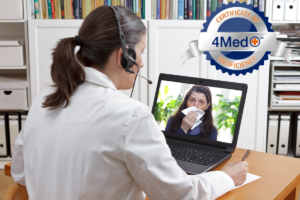 Telehealth as a viable healthcare delivery channel had shown minimal growth prior to Covid-19. Then, due to the extreme urgency of the crisis, Medicare and numerous 3rd party insurers elevated telehealth encounter reimbursement to parity with face-to-face encounters. Within a matter of weeks providers rushed to locate and begin using the technology. Usually changes in healthcare workflows and processes can take years to become refined and established but this was not the case in the need for telehealth technology. There was no time for proper due diligence in the selection of an appropriate telehealth platform. There was no time to create a seamless workflow to support this new channel of healthcare delivery. With the temporary relaxation of HIPAA enforcement, many providers grabbed the first thing they found on the shelf. Many of the products were never designed for secure communication with patients nor were they capable of even minimal clinical documentation.
Telehealth as a viable healthcare delivery channel had shown minimal growth prior to Covid-19. Then, due to the extreme urgency of the crisis, Medicare and numerous 3rd party insurers elevated telehealth encounter reimbursement to parity with face-to-face encounters. Within a matter of weeks providers rushed to locate and begin using the technology. Usually changes in healthcare workflows and processes can take years to become refined and established but this was not the case in the need for telehealth technology. There was no time for proper due diligence in the selection of an appropriate telehealth platform. There was no time to create a seamless workflow to support this new channel of healthcare delivery. With the temporary relaxation of HIPAA enforcement, many providers grabbed the first thing they found on the shelf. Many of the products were never designed for secure communication with patients nor were they capable of even minimal clinical documentation.
Perhaps it is not too late for providers to benefit from 20/20 hindsight and examine their decisions made in haste. It is never too late to start off on the right path based on best practices and lessons learned. Here are my thoughts of how to incorporate telehealth in a practice once appropriate use cases are identified.
3 Steps to the Successful Adoption of Telehealth
Selection: The first critical step is the selection of a telehealth platform that meets certain minimum requirements. This includes such functionality as ease of use, HIPAA compliance, multiple participants in a session, clinical documentation tools, and the flexibility to be adaptable to various use cases. Also important is the ability for screen share, file exchange, capturing patient consent, robust scheduling capability, and report generation. This is certainly not a complete list of what I feel is important but what I’m trying to convey is that if you will be offering telehealth it must be on a robust and mature platform.
Practice integration: A clear understanding of how telehealth will be used is critical to the process. Who in the practice will use telehealth and how will it be documented? How will the encounter translate to billing? How will patient consent be obtained? How will determinations be made to develop policies and procedures related to workflow, use cases, scheduling, and other issues that will affect the practice? You do not want the adoption of telehealth to be a giant distraction, you want it to bring added value to your overall delivery of healthcare. Don’t try and “wing” the integration process.
NEW Best Practices: In the past few months, the expansion of telehealth use has revealed a number of best practices that have proven to ease the transition to a stable telehealth service. I’m sure more will arise but here are a few that are among the most significant:
• Notify patients that telehealth visits are now offered by the practice and explain benefits.
• Prior to a scheduled session, send a notification to the patient via email or text as a reminder.
• Select a quiet location with good lighting and a strong internet signal.
• When the session begins, make sure the patient’s equipment is working and they can hear and see you clearly.
• Identify yourself to the patient and obtain informed consent for telehealth care.
• Keep the visit as much like an in-person visit as possible.
• Make sure each session includes appropriate clinical documentation as well as what is needed to meet reimbursement requirements.
• Ask patients for feedback as to the workflow and technology. Did they have any difficulties? Do they have any suggestions?
 BECOME A CERTIFIED TELEHEALTH SKILLED PROFESSIONAL: This accredited online course provides comprehensive training for clinicians and coordinators of telehealth services in medical environments. It includes hands-on telehealth platform lessons using real world samples and tools. CLICK FOR COURSE INFO
BECOME A CERTIFIED TELEHEALTH SKILLED PROFESSIONAL: This accredited online course provides comprehensive training for clinicians and coordinators of telehealth services in medical environments. It includes hands-on telehealth platform lessons using real world samples and tools. CLICK FOR COURSE INFO
![]()
FREE LEARNING EVENT: A Post-Covid-19 Plan for Telehealth
4MedPlus will be presenting this FREE one hour learning event on July 29, 2020 at Noon EDT, 11am Central 10am Mtn and 9am Pacific
Registration is required, but attendance in the live session is not required. All registrants will receive a link to the recorded event on the very same day! CLICK TO REGISTER

